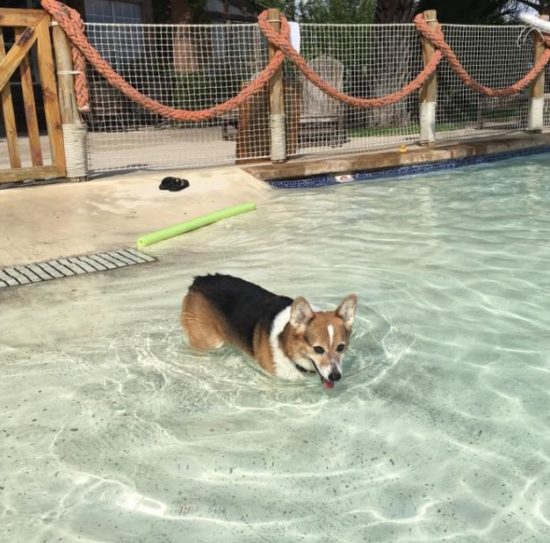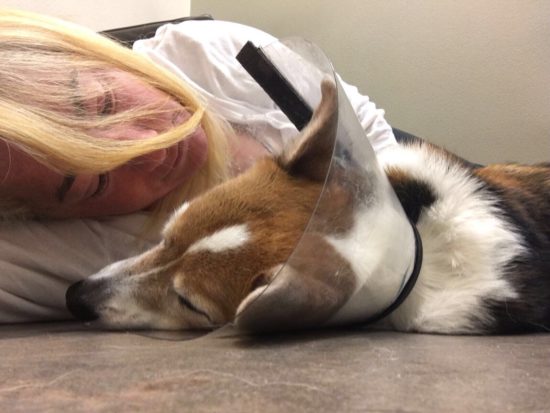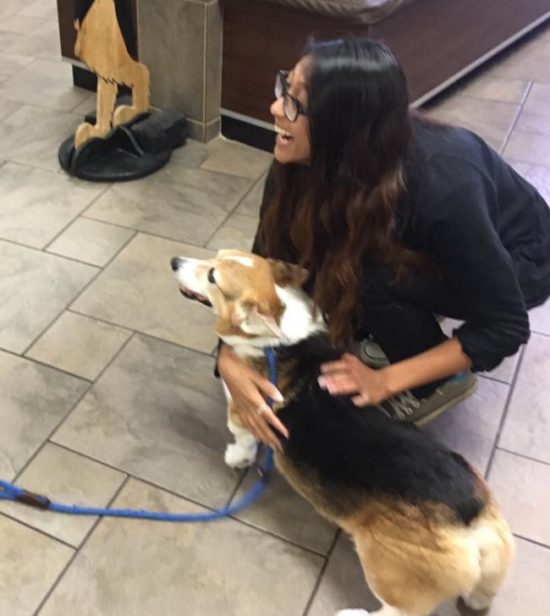Today we have a guest post from reader Alison Kratish of Texas. Her story reminds me of many others from dog lovers braving the trenches with their own sick puppers. Perhaps you will find yourself and your own experience reflected in her description of the play-by-play, the intensity, the quickening heartbeat that follows bad news about our beloveds.
This kind of dedication and commitment (and all that love!) are inspiring. And a family member is worth fighting for. We give them everything we can, because a loyal animal companion entrusts himself to our care. That’s the deal.
Not all endings are happy ones, but Cody’s is an unlikely happy-ending-in-progress. One day at a time, and against all odds, Team Cody is getting it done. Join me in cheering them on.
Corgi On, my friends. Corgi On fiercely and fearlessly!
Laurie

Allison Schmidt Photography
Cody Kratish, a red-headed tri color PWC from Houston, Texas was living a charmed life with me, Alison, and his sister, LuLu, another red-headed tricolor Corgi. The three of us moved back to Houston together six years ago after living life on the road running a mobile doggie day care service called The Pooch Paddock, with Cody as mascot. He had faced some adversity after life on the road, but nothing life-threatening or frightening. He suffered two torn ACL’s within a four-month span in late 2011/early 2012 and got through his TPLO procedures just fine.

Keeping Mom company in the bathroom. Don’t laugh, you bring your phone too.

Allison Schmidt Photography
All the handsome. Right here. Uh-huh.

Cody just a week before he got sick.
After that, Cody was good as new for more than four years. Until he wasn’t.
One day early last June — the fourth, to be exact — Cody, who was nine, seemed a little out of sorts. He’d been a bit tired for a few weeks, but nothing I was terribly concerned about. He’d gone on a few outings and a weekend away at a river house with a pool, so I just chalked it up to aging. But the morning of the fourth he was drooling a lot, which was very unusual for Cody. Something made me check his gums. Divine intervention, perhaps?
Gum checking was not part of our regular routine. In fact, I’d never before checked the gums of any of my dogs, but SOMETHING told me to look at them that morning, a Saturday. They were pale. Alarmingly pale. I rushed him to my car and over to the quickie vaccination vet clinic that I knew was open until 1 p.m. on Saturdays and asked them to run an in-house CBC. The look on the vet’s face when she brought me the results was horrifying. She told me Cody’s red blood cell count was very, very low and his fever was 103.5. She explained that the primary reasons for red blood cells to be diminished were either internal bleeding or an immune disorder.
Having had friends who had lost dogs to whatever that immune disorder is (at the time I could not remember the name), and having seen a few ‘in memoriam’ posts on The Daily Corgi about dogs that had succumbed to it, I knew this was not going to be a good day. At all.
The clinic vet advised me to head immediately to the nearest emergency veterinary hospital for further testing and IV fluids for my baby, and possibly even a blood transfusion. I burst into tears and put Cody back in the car, than raced to the ER hospital just down the road. In the time between the original vet and the ER Vet temperature taking, his fever went up a whole point. He was lethargic in the back of my car — not his normal, excited to be going someplace self — and I was TERRIFIED.
The ER vet hospital immediately took him in the back and ran all kinds of tests on him. Bloodwork, x-rays, ultrasound. They needed to rule out internal bleeding and/or a tumor of some sort that could be the cause of him losing red blood cells. They also ran a full panel of diagnostic blood work to test the way his blood clotted. One of the telltale signs of Immune Mediated Hemolytic Anemia (IMHA) is the way the remaining red blood cells “clump” together. Another is something called a Coombs test, which tests for certain antibodies related to this disorder. When the vet phoned me later that night, sure enough, the tests were positive for IMHA. A devastating blow.
Cody is THAT dog for me. I’ve had other dogs and I have another Corgi presently, whom I love dearly, but the bond I share with Cody is vastly different from any other dog I’ve ever had. I do not have human children; he is my baby. I was heartbroken and completely panicked.
The vets at the ER hospital explained that IMHA is usually fatal. They were uncomfortable giving me even 50/50 odds. In fact, they would not even admit to ever having treated a dog successfully through treatment at that particular clinic. There was talk of “oh, yes, we’ve heard of dogs beating it before, but we’ve never seen it”. They scheduled Cody for an immediate blood transfusion to try and give his red blood cell count a temporary boost, which really only buys time for the drugs to kick in.

He protested the “will bite” warning on his cage, because he snapped at the lady who was taking his temperature at five minute intervals during the transfusion. (I’d bite her too!)
The drugs used to treat Immune Mediated Hemolytic Anemia are a cocktail combination of immune-suppressing drugs, with Prednisone — a terrible steroid with lots of side effects — being the keystone of the treatment plan. Any other drugs are by trial and error and really are just a personal preference of the vet in charge of the treatment plan. The ER vet immediately started Cody on the Prednisone and one other immune-suppressant called Azathioprine, a drug used in human organ transplant patients to help prevent the body from rejecting the donated organ. You see, in IMHA the body is essentially rejecting its own healthy red blood cells. Somehow, his own immune system has decided the healthy red blood cells are the enemy and has set out to destroy them, at an alarming pace. Sometimes the destruction is triggered by an outside force: a tick-borne illness, cancer, infection, exposure to pesticides or some medication that can trigger the immune system to go haywire. In Cody’s case, we could not find a cause. The diagnosis: Idiopathic IMHA. No known trigger. The immune suppressant drugs are meant to kill the immune system so that his immune system doesn’t kill him.

The morning after the transfusion. He was a lot more energetic after that.
After one transfusion and two nights in the hospital, Cody’s red blood cell count stabilized to a number that was not dangerously low, but was not yet in normal range (about 10 points below normal, to be exact) and they allowed him to come home but advised me to see an internal medicine specialist to formulate an ongoing treatment plan. They released him to me with a grocery bag full of medications and a laundry list of instructions on how to medicate Cody round the clock.
Round. The. Clock.
He came home on a Monday, and by Wednesday morning, we were sitting in the waiting area of a large specialty veterinary hospital in Houston waiting to see the Internal Medicine guy who had an opening that day. Fortunately, we got a good one! Dr. Jones ran his bloodwork that morning and it had dropped another 7 points. He immediately added a third immune suppressant drug called Cyclosporine, another medication sometimes used on human organ transplant patients. Another drug to add to the round the clock schedule of administering meds at different times, x-number of hours apart from each other.
Dr. Jones remarked that Cody’s demeanor seemed perky enough to send home with me that day, even though his red cell count was markedly lower than it had been two days prior, when he was released from the hospital. The instruction was to start the new medication and re-test the red blood cell count daily so we could make sure a downward trend wasn’t happening.
We did as instructed and the next day the count had gone up a few points. Relief. Somewhat, though I took the week off from work to watch him like a hawk. Everything I’d read online about this dreadful disease said that things could change and go rapidly downhill in a matter of hours, meaning people had left their homes while their dog was normal and perky and returned to a listless, collapsed dog within two hours. I could not sleep. I could not leave home for more than an hour at a time. All I could do was watch him and wait ’til the next day to have him retested. Each day thereafter, his count increased, little by little.

Having the heart to heart about fighting IMHA, the day after his diagnosis.
I was bound and determined we were going to fight this all the way through. Death was NOT an option. I went online in those sleepless nights and read everything I could lay eyes on about this terrible disease. None of it was good news, but there were encouraging moments where there was a survival story or two. The first one was a friend on Facebook, a former client in my doggie day care business, who posted her well wishes along with a story about a dog she had years ago that lived with IMHA for four years.
A glimmer of hope. Finally.
Then I was directed to a Facebook page specifically dedicated to owners of dogs with IMHA, where I found hundreds of folks with similar stories, many of whom had been battling IMHA successfully for two, three, four or even more years. My competitive nature took hold and I was now on a mission to give myself a vet school’s education on how to treat and manage this disease. Some might even say I micro-manage it.
I read every post, good and bad. I cried a lot in between reading something on the page, then immediately going to Google to dig deeper about the things people on the page had suggested worked for their dog(s). I became a sponge for any IMHA related information. There I learned about holistic treatments for some of the side effects and ancillary infections of the medications Cody would now need to be on for months, if not years or the rest of his life.
The flip side to suppressing the immune system is that Cody would be susceptible to dangerously high liver enzymes, ancillary infections, because his squatty Corgi body will not be able to fight any bacteria or viral infections off. Any possible contagious ailment that another dog could carry could now be passed on to my baby if he came into contact with it. Our lives were changed forever. He could no longer go to the park or be friendly with other dogs we encountered along our walks, for fear that he might catch something communicable.
We had to adjust. He still has to be a dog. I cannot keep him in a bubble.
Our entire routine was uprooted but we made adjustments as necessary, and improvements in his counts followed. That Facebook page, much like the Daily Corgi, was a go-to for information, support and ears to listen and lend information to others newly faced with IMHA. There are new ones joining there every day. It’s scary thought to think that this disease is so much more prevalent than I could have imagined, but regardless of the numbers I’m seeing there, I suppose in the grand scheme of things, IMHA is still considered a relatively rare disease. One of the difficult things about it is that there doesn’t seem to be a ton of research available on it. That was a bitter pill to swallow (no pun intended).
It surprised me to learn that veterinary research is nowhere near as extensive as research on human ailments. The dollars just aren’t there. So when you look up IMHA in dogs online, the outlook seems bleak. Very, very bleak. But through the powers of social media and the FB page dedicated to this disease, cautious optimism set in and my scrappy little boy Cody jumped right on board with my competitive spirit, and together we began to fight the good fight.

Spreading Corgi Power at the vet, where he gets a cookie after his routine blood draws.
Three weeks after diagnosis, his count hit a normal range number. The drugs were working! We’ve had a few ups and downs along the way, including two urinary tract infections, the start of an eye infection (caught so early the vet couldn’t believe I’d noticed), one ear infection and one additional hospitalization for pancreatitis last November, apparently caused by fragments chewed off of a deer antler.
We don’t buy those anymore. Lesson learned the hard way
Now, as we approach early April, we are 10 months into this ordeal. Cody has been stable since his November bout with pancreatitis. We continue to test his red blood cell values every week and once a month we see the specialist to do a full chemistry panel on his blood to make sure his liver and kidney functions are ok. Due to some of the knowledge I gained on the IMHA Facebook page, we’ve even been able to get his high liver enzymes DOWN in the last two months using some holistic medication to boost his liver function. A feat even the specialist was skeptical of.
The name of the game now is to try and wean Cody down to maintenance level doses of the immune suppressors without causing a relapse. Relapses are very common with IMHA and it is a delicate balance to find the right combination and dose of the drugs that work to keep each of these IMHA dogs in remission. Every vet takes a different approach to this process and ours does not believe in totally weaning down to nothing, so Cody will likely be on some sort of low maintenance dose of at least two of his current medications.
BUT—my boy has his health and his personality back, despite the drugs he has to live on. He is mostly confined to home, but we’ve moved into a place that has its own little yard and I now live with my dad, so that Cody and his sister, LuLu have someone home with them more often.
He is happy and perky and is still the stubborn Corgi he has always been. He thinks it’s great to get so many treats all day/night long — we just don’t tell him there are pills hidden inside. As for his gums? Yeah, well, those are checked about five times a day now. He’ll likely never get used to that, but it’s a small price to pay to have Cody with me against all odds.




What an inspiring story. Thank you for sharing it with us
Thank you for reading it!
My corgi Bun went through something similar with her kidneys when she was just six months. The doctors thought it was congenital because she was so young, and were talking about possible kidney removal or transplants. It was devastating. But somehow, we got lucky. We quickly reduced her protein intake and cleared up a kidney infection she had. A few weeks later we went in to test her levels again and they were still not normal, but not worse. We kept our fingers crossed and came back in for testing periodically. One week, then three, then a month. Each time her BUN (the irony of her being named Bun with high BUN levels was not lost on my husband and me) and CREA levels inched a little higher. We put her on a vegetarian diet. They got a little better. They are still not quite in the normal range and an ultrasound did show her kidneys are underdeveloped, but for the time being, she is a stable, happy dog. She’s smaller than average, 15.5 pounds at just over a year, and we know there will likely be complications down the road, but we are just happy to have her for as long as we can. My experience was like yours when reading things online — kidney problems, especially in a puppy, are bad, really bad. But our pup is a fighter, just like Cody. My thoughts are with you and Cody, I hope he continues to be a happy boy!
Thank you for sharing Bun’s story, Cecilia. Sending positive thoughts for continued improvement for your girl.
I’m so sorry that you and Cody have to go through all of this but I really appreciate the time you have taken to share your story with all of us. I’ve never heard of this but I now know the symptoms in case (God forbid) that my Loki should ever have them. I pray that Cody will continue to have a long and happy life!
Thank you, Anne! it’s been a long, hard road but I feel blessed to have been able to do this for my boy.
Apart from saying how happy I am for you both, I wanted to add another positive story related to IMHA. Our Cardigan Corgi, Finn, went through exactly the same in August 2015 just after his second birthday. The same lethargy and some nose bleeding, which we feared might be nasal cancer, but was in fact just the crazy blood clotting associated with IMHA. By the time we had a diagnosis he was in the vet hospital, talk of amputating bits and pieces and transfusions. He got home after 5 days in the hospital, 5 days on drips etc without food (which for a food-motivated corgi was hell). 3 kg lighter and an the full menu of prednisone, cyclosporin and azathioprine. The next 3 months were complete hell for all of us – the prednisone is such a nasty drug. I remember weekly (or more frequently) vet trips, the nervous wait for his bloods, the celebrations as he made gradual progress. And finally weaning him off the lot after 6 or 7 months. And now…fingers crossed…you wouldn’t believe he had been through it. Yes, we check his gums constantly, worry if he as much as sneezes, but mostly just enjoy having him back to being Finn. I think the more positive stories there are the better. Most of the stuff out there is negative and gives you no hope. The message is that it can work out ok, but it is a slog and you are never sure.
Good luck to you and Cody, from Finn in New Zealand
I’m just now getting around to reading these comments under our story (it’s been a busy few weeks, sorry). Thank you for sharing Finn’s story. Yes, I agree. The more positive stories out there related to IMHA, the better and more inspirational for those newly diagnosed to be motivated to FIGHT!
Your story is very encouraging. My baby is going through the same thing right now, except that she’s had five blood transfusions by now. Because her numbers are not going up enough and dropping down quickly, but seeing that there’s a possibility to prolong their life makes me so much more hopeful! Thank you for sharing!